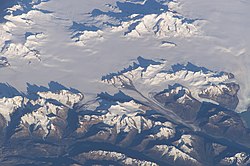Icefield
An ice field (also spelled icefield) is a mass of interconnected valley glaciers. It is also known as mountain glacier or alpine glacier.
It lies on a mountain mass with sticking out rock ridges or summits. Due to ice's likelihood of being harmed or influenced by gravity, ice fields usually form over large areas that are drained by a river.
The higher peaks under the mountain rock that stick out through the icefields are known as nunataks. Ice fields are larger than Alps-based glaciers, but smaller than ice caps and ice flat materials.
An ice field is also measurable from an ice cap because it does not have a dome-like form.
Icefield Media
The Southern Patagonian Ice Field between Chile and Argentina.
The Harding Icefield on the Kenai Peninsula in Alaska, United States.
Related pages
| Wikimedia Commons has media related to Lua error in Module:Commons_link at line 62: attempt to index field 'wikibase' (a nil value).. |
Sources
- Strahler, Alan H. (April 2001). Introducing Physical Geography. John Wiley & Sons Incorporated (published 2001). ISBN 978-0-471-09017-5.
- Casassa, Gino; Sepúlveda, Francisco V.; Sinclair, Rolf M. (2012-12-06). The Patagonian Icefields: A Unique Natural Laboratory for Environmental and Climate Change Studies. Springer Science & Business Media. ISBN 978-1-4615-0645-4.
- Monahan, Patricia A.; Ramage, Joan (2010). "AMSR-E melt patterns on the Southern Patagonia Icefield". Journal of Glaciology. 56 (198): 699–708. doi:10.3189/002214310793146197. ISSN 0022-1430. S2CID 130936674.
- Conway, J. P.; Helgason, W. D.; Pomeroy, J. W.; Sicart, J. E. (2021-03-27). "Icefield Breezes: Mesoscale Diurnal Circulation in the Atmospheric Boundary Layer Over an Outlet of the Columbia Icefield, Canadian Rockies". Journal of Geophysical Research: Atmospheres. 126 (6). doi:10.1029/2020JD034225. ISSN 2169-897X. S2CID 233894323.


